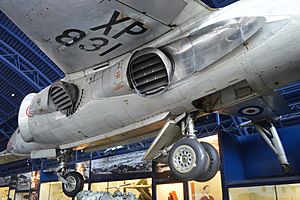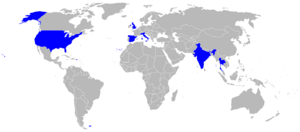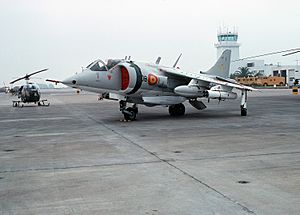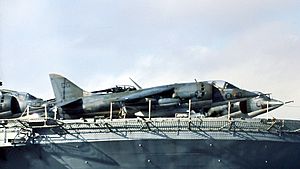Harrier jump jet facts for kids
Quick facts for kids Harrier jump jet |
|
|---|---|
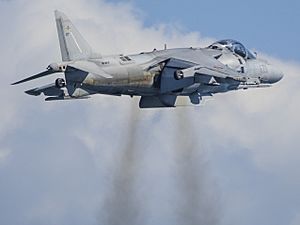
A Harrier II in hover with downward jet exhaust
|
|
| General information | |
| Type | V/STOL strike aircraft |
| National origin | United Kingdom |
| Manufacturer | Hawker Siddeley British Aerospace / McDonnell Douglas Boeing / BAE Systems |
| Status | In service |
| Primary users | United States Marine Corps |
| History | |
| Manufactured | 1967–2003 |
| Introduction date | 1969 |
| First flight | 28 December 1967 |
| Developed from | Hawker Siddeley P.1127 |
| Variants | Hawker Siddeley Harrier British Aerospace Sea Harrier McDonnell Douglas AV-8B Harrier II British Aerospace Harrier II |
The Harrier is a special type of jet plane. People often call it the Harrier jump jet. What makes it unique is its ability to take off and land almost straight up! This is called vertical/short takeoff and landing (V/STOL).
This amazing aircraft was first made in the 1960s by a British company called Hawker Siddeley. It was named after a fast bird of prey, the Harrier. The Harrier was the only successful V/STOL plane from that time. It was designed to fly from small, simple places like car parks or clearings in forests. This meant it didn't need big, easy-to-attack air bases. Later, it was also used on aircraft carriers at sea.
There are two main types, or generations, of the Harrier family. They were made by both UK and US companies:
- Hawker Siddeley Harrier (first generation)
- British Aerospace Sea Harrier
- McDonnell Douglas AV-8B Harrier II (second generation)
- British Aerospace Harrier II
The first Harrier, the Hawker Siddeley Harrier, was used by many air forces. These included the Royal Air Force (RAF) in the UK and the United States Marine Corps (USMC). The Sea Harrier was a special version for navies. It could defend ships and attack targets. Both the Royal Navy and the Indian Navy used it.
In the 1980s, a new, improved Harrier appeared. It was called the AV-8B in the US and the British Aerospace Harrier II in the UK. By the early 2000s, most of the older Harriers were replaced by these newer ones. Today, some countries are replacing their Harriers with the F-35 Lightning II, which also has V/STOL abilities.
Contents
How the Harrier Was Made
Early Ideas for Jump Jets
In the 1950s, after the Korean War, many aircraft companies started thinking about planes that could take off and land vertically. This idea was exciting because it meant planes wouldn't need long runways. Runways could be easily attacked in a war. People even thought this technology could be used for passenger planes! But back then, most thought a vertical take-off plane couldn't also be a fast, powerful military jet.
In 1957, a British engine company, Bristol Engine Company, came up with a new engine design. It was called the Pegasus. This engine had special nozzles that could turn. These nozzles could direct the engine's powerful air jets downwards for vertical flight. Then, they could turn backwards for regular forward flight. This was a very clever idea!
A designer named Ralph Hooper at Hawker Aircraft quickly started drawing a plane that could use this Pegasus engine. In 1959, Hawker Siddeley decided to build two test planes, called the P.1127. These planes would show if the design worked. The P.1127 caught the attention of the RAF. They wanted a V/STOL plane for ground attacks. In 1965, the RAF ordered six test planes, which led to the Harrier.
First Harriers Take Flight
The first Harriers were the Hawker Siddeley Harrier GR.1/GR.3 and the AV-8A Harrier. These were the first planes that could attack targets and fly reconnaissance missions while taking off and landing vertically or very short. They were based on the P.1127 test planes.
On April 18, 1969, the Harrier GR.1 officially joined the RAF. The United States Marine Corps (USMC) also bought these planes. They received 102 AV-8A Harriers between 1971 and 1976.
The British Aerospace Sea Harrier was a special naval version. It could fight other jets, scout, and attack. The first Sea Harriers joined the Royal Navy in April 1980. They were sometimes called the Shar. Sea Harriers became famous during the Falklands War in 1982. They flew from aircraft carriers like HMS Invincible and HMS Hermes. After the war, an improved version, the Sea Harrier FA2, was made. It started flying in 1993. The Indian Navy also used Sea Harriers.
Second Generation Harriers
By 1973, Hawker Siddeley and the American company McDonnell Douglas were working together. They wanted to make an even better Harrier. They focused on improving the Pegasus engine. In 1981, British Aerospace (BAe) joined the project.
McDonnell Douglas (now part of Boeing) and British Aerospace (now part of BAE Systems) greatly improved the Harrier. This led to the second generation of these special jets. The American version was called the AV-8B Harrier II.
The first AV-8B was given to the USMC on December 12, 1983. The AV-8B is mainly used for attacking targets. It often flies from smaller aircraft carriers. The RAF also bought the British-made second-generation Harrier, called the Harrier II GR5/GR7/GR9. It started service in the mid-1980s. Other NATO countries like Spain and Italy also used this model. The British Harrier II was used by the RAF and later the Royal Navy until 2010.
Between 1969 and 2003, 824 Harriers of all types were built. Even though new Harriers stopped being made in 1997, the last rebuilt Harrier was delivered in 2003.
How the Harrier Flies
The Harrier jump jet can take off vertically, but only when it's not carrying too much weight. Most of the time, it needs a short take off to carry enough fuel and weapons. This uses forward speed to help the jet lift off. A short take-off also uses less fuel than a vertical take off. On some aircraft carriers, a ski-jump ramp helps the plane get into the air.
Landing is usually done almost vertically, but with some forward speed. This is called a shipborne rolling vertical landing (SRVL). The Harrier can also turn its nozzles slightly forward during flight. This is called "vectoring in forward flight" or "VIFFing". It's a trick used in dogfights to slow down very quickly. This can make a chasing plane fly past, making it an easy target for the Harrier. This trick was developed by the USMC in the 1970s.
The wind direction is very important when the Harrier takes off or lands vertically. If the wind doesn't blow straight into the engine, it can push the plane sideways. Pilots have a special wind vane to help them keep the plane pointed into the wind. For a vertical take-off, the pilot points the plane into the wind. The turning nozzles are pointed straight down, and the engine power is increased until the plane lifts off. For a short take-off, the nozzles are pointed partly downwards at a low speed. This gives extra lift from the jets.
The Harrier also has a special system called the reaction control system. It uses small jets of air at the nose, tail, and wingtips. These jets help control the plane's movement when it's flying slowly or hovering. They work before the regular control surfaces (like elevators and ailerons) become effective.
Pilots have said the Harrier is "unforgiving" to fly. It can fly like a regular plane, hover, and do short take-offs and landings. Switching between hovering and regular flight needs a lot of skill. The Harrier has an extra lever in the cockpit to control the direction of the four nozzles. For regular flight, the nozzles point backward. For vertical or short take-offs and landings, the lever is pulled back to point the nozzles down.
What Replaced the Harrier?
In 2010, the RAF and Royal Navy announced they would stop using their Harriers by 2011. In December 2010, the RAF's Harrier GR9s flew their last missions. In 2011, the remaining 72 Harriers were sold to the US Marine Corps. They used them for spare parts to keep their own AV-8B fleet flying.
As of July 2025, the F-35 Lightning II (specifically the F-35B model) has replaced the AV-8B Harrier II for the US Marine Corps. The RAF and Royal Navy started using the F-35B in June 2018.
By March 2021, the Italian Navy's AV-8Bs were replaced by F-35Bs. The Indian Navy stopped using their Sea Harriers in 2016. They replaced them with the Mikoyan MiG-29K. Spain was also looking to replace its Harriers with the F-35B. However, in May 2014, Spain decided to keep its Harriers flying past 2025 because they didn't have enough money for new planes.
Harrier Types
Here are some of the different types of Harrier aircraft:
- Hawker P.1127
- (1960) This was the very first test plane that led to the Harrier.
- Kestrel FGA.1
- (1964) A test version used for evaluations.
- Harrier GR.1/1A/3/3A
- (from 1966) The first generation of Harriers used by the RAF.
- Harrier T.2/2A/4/4A/8/52/60
- (from 1970) Two-seat trainer versions of the Harrier.
- AV-8A/C/S Harrier Mk.50/53/55/Matador
- The first generation Harriers used by the US Marine Corps and Spain.
- TAV-8A/S Harrier Mk.54/Matador
- Two-seat trainer versions for the US Marine Corps and Spain.
- Sea Harrier FRS.1/FRS.51/F(A).2
- (from 1978) The naval version used by the Royal Navy and Indian Navy.
- AV-8B Harrier II/EAV-8B Matador II/AV-8B Harrier II Night Attack/AV-8B Harrier II Plus
- (from 1983) The second generation Harriers used by the US Marine Corps, Spain, and Italy.
- TAV-8B Harrier II/ETAV-8B Matador II/
- Two-seat trainer versions of the second generation.
- Harrier GR.5/5A/7/7A/9/9A
- (from 1985) The second generation Harriers used by the RAF.
- Harrier T.10/12
- Two-seat trainer versions of the second generation for the RAF.
Images for kids
-
RAF Harrier GR9 arrives at RIAT 2008
Who Uses the Harrier?
Here are the countries that have used or still use the Harrier:
- Indian Navy (used to use them)
- Italian Navy (used to use them)
- Spanish Navy (still uses them)
- Royal Thai Navy (used to use them)
- Royal Air Force (used to use them)
- Royal Navy (used to use them)
- United States Marine Corps (still uses them)
Harrier Specifications
The Harrier aircraft family has a unique way of controlling its flight. It uses two types of control:
- Normal control surfaces (like wings and tail flaps) for regular flying.
- Special reaction control valves that direct jets of air from the engine. These jets come out of the nose, tail, and wingtips. They are used when the plane is hovering or flying very slowly.
These two systems work together. The air jets are only used when the plane is hovering or flying slowly.
| Kestrel FGA.1 | Harrier GR3/AV-8A | Sea Harrier FA2 | Harrier GR9 | AV-8B+ Harrier | |
|---|---|---|---|---|---|
| Crew | One pilot (Two for trainer versions) | ||||
| Length | 42 ft 6 in (13.0 m) | 47 ft 2 in (14.4 m) | 46 ft 6 in (14.2 m) | 46 ft 4 in (14.1 m) | 47 ft 8 in (14.5 m) |
| Wingspan | 22 ft 11 in (6.98 m) | 25 ft 3 in (7.70 m) | 25 ft 3 in (7.70 m) | 30 ft 4 in (9.25 m) | 30 ft 4 in (9.25 m) |
| Height | 10 ft 9 in (3.28 m) | 11 ft 4 in (3.45 m) | 12 ft 4 in (3.76 m) | 11 ft 8 in (3.56 m) | 11 ft 8 in (3.56 m) |
| Empty weight | 10,000 lb (4,540 kg) | 12,200 lb (5,530 kg) | 14,052 lb (6,370 kg) | 12,500 lb (5,670 kg)? | 13,968 lb (6,340 kg) |
| Maximum take-off weight (short takeoff) |
17,000 lb (7,710 kg) | 26,000 lb (11,800 kg) | 26,200 lb (11,900 kg) | 31,000 lb (14,100 kg) | 31,000 lb (14,100 kg) |
| Max speed | 545 mph (877.1 km/h) | 731 mph (1,176 km/h) | 735 mph (1,183 km/h) | 662 mph (1,065 km/h) | 662 mph (1,065 km/h) |
| Combat radius | 200 nmi (370 km) | 300 nmi (556 km) | 300 nmi (556 km) | ||
| Engine | Pegasus 6 | Pegasus 11 Mk 101 | Pegasus 11 Mk 106 | Pegasus 11 Mk 107 | Pegasus 11 Mk 105 |
| Thrust | 15,000 lbf (66.7 kN) | 21,800 lbf (97.0 kN) | 21,800 lbf (97.0 kN) | 24,750 lbf (110 kN) | 23,500 lbf (105 kN) |
| Radar | None | None | Blue Fox / Blue Vixen | None | AN/APG-65 |
- Sources: Nordeen
More About Harriers
- Aircraft in fiction - Harrier family
- Lockheed Martin F-35 Lightning II
- Aircraft related to this one
- Hawker P.1127/Hawker Siddeley Kestrel
- Hawker Siddeley Harrier
- McDonnell Douglas AV-8B Harrier II
- British Aerospace Harrier II
- Similar aircraft
- Bell X-14
- Ryan XV-5 Vertifan
- Short SC.1
- Yakovlev Yak-36
- Yakovlev Yak-38
- Lists related to this aircraft
- List of VTOL aircraft
- List of attack aircraft
- List of fighter aircraft
See also
 In Spanish: Harrier para niños
In Spanish: Harrier para niños


